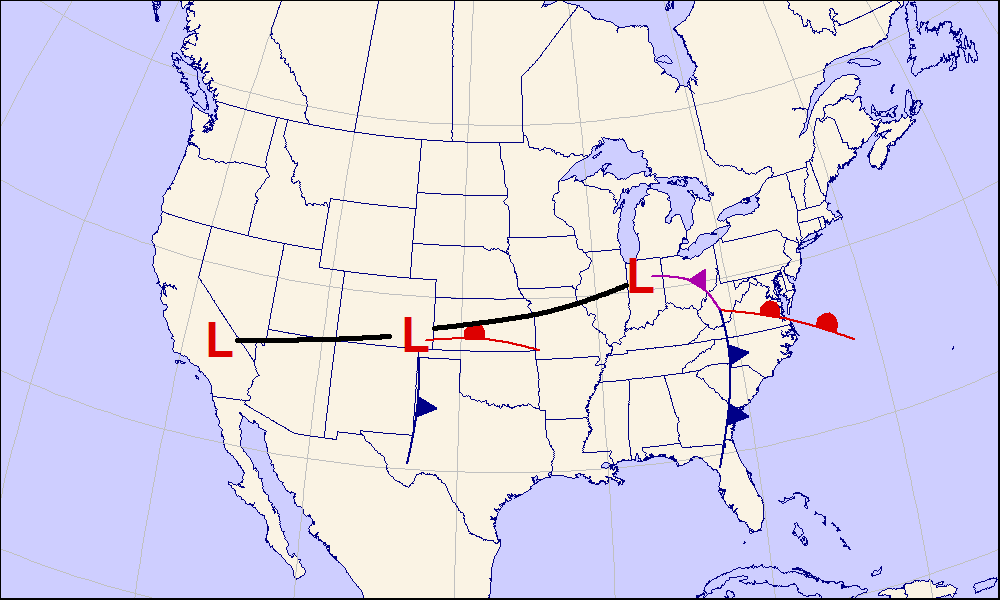Colorado Low on:
[Wikipedia]
[Google]
[Amazon]
 A Colorado low is a
A Colorado low is a
 A Colorado low is a
A Colorado low is a low-pressure area
In meteorology, a low-pressure area (LPA), low area or low is a region where the atmospheric pressure is lower than that of surrounding locations. It is the opposite of a high-pressure area. Low-pressure areas are commonly associated with incle ...
that forms in southeastern Colorado
Colorado is a U.S. state, state in the Western United States. It is one of the Mountain states, sharing the Four Corners region with Arizona, New Mexico, and Utah. It is also bordered by Wyoming to the north, Nebraska to the northeast, Kansas ...
or northeastern New Mexico
New Mexico is a state in the Southwestern United States, Southwestern region of the United States. It is one of the Mountain States of the southern Rocky Mountains, sharing the Four Corners region with Utah, Colorado, and Arizona. It also ...
, typically in the winter. After forming, the system moves across the Great Plains
The Great Plains is a broad expanse of plain, flatland in North America. The region stretches east of the Rocky Mountains, much of it covered in prairie, steppe, and grassland. They are the western part of the Interior Plains, which include th ...
. Colorado lows can produce heavy wintry precipitation
In meteorology, precipitation is any product of the condensation of atmospheric water vapor that falls from clouds due to gravitational pull. The main forms of precipitation include drizzle, rain, rain and snow mixed ("sleet" in Commonwe ...
, and have a general east to northeast movement, impacting regions as far north as Winnipeg
Winnipeg () is the capital and largest city of the Provinces and territories of Canada, Canadian province of Manitoba. It is centred on the confluence of the Red River of the North, Red and Assiniboine River, Assiniboine rivers. , Winnipeg h ...
and as far east as the Atlantic coast. If upper-level conditions are right, the jet stream
Jet streams are fast flowing, narrow thermal wind, air currents in the Earth's Atmosphere of Earth, atmosphere.
The main jet streams are located near the altitude of the tropopause and are westerly winds, flowing west to east around the gl ...
can push the low farther south, bringing wintry precipitation as far as Texas. When pushed this far south, the system is often referred to as a " blue norther". On the more typical track, a Colorado low can be similar to an Alberta clipper
An Alberta clipper, also known as an Alberta low, Alberta cyclone, Alberta lee cyclone, Canadian clipper, or simply clipper, is a fast-moving low-pressure system that originates in or near the Canadian province of Alberta just east of the Rocky ...
. In the winter Colorado lows are responsible for a majority of the snow that the Midwest
The Midwestern United States (also referred to as the Midwest, the Heartland or the American Midwest) is one of the four census regions defined by the United States Census Bureau. It occupies the northern central part of the United States. It ...
receives; however, summer systems can trigger long-lasting convective systems, including severe weather
Severe weather is any dangerous meteorological phenomenon with the potential to cause damage, serious social disruption, or loss of human life. These vary depending on the latitude, altitude, topography, and atmospheric conditions. High ...
. Spring and early summer Colorado low cyclogenesis
Cyclogenesis is the development or strengthening of Cyclonic rotation, cyclonic circulation in the atmosphere (a low-pressure area). Cyclogenesis is an umbrella term for at least three different processes, all of which result in the development of ...
can result in significant tornado outbreak
A tornado outbreak is the occurrence of multiple tornadoes spawned by the same Synoptic scale meteorology, synoptic scale weather system. The number of tornadoes required to qualify as an outbreak typically are at least six to ten, with at least ...
s over the Great Plains and Midwest.
See also
* Denver Convergence Vorticity Zone (DCVZ) * Gulf low *Nor'easter
A nor'easter (also northeaster; see below) is a large-scale extratropical cyclone in the western North Atlantic Ocean. The name derives from the direction of the winds that blow from the northeast. Typically, such storms originate as a low ...
* Panhandle hook
References
External links
{{DEFAULTSORT:Colorado low Extratropical cyclones Regional climate effects fr:Tempête synoptique continentale américaine#Dépression du Colorado